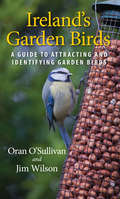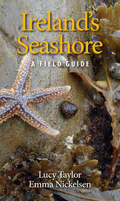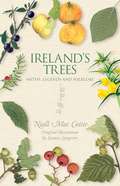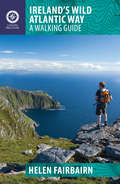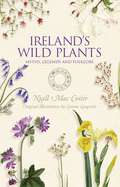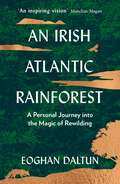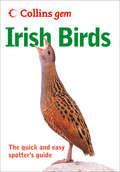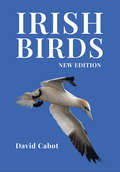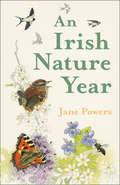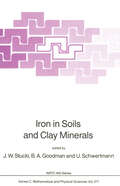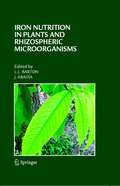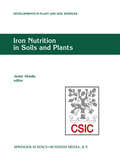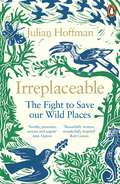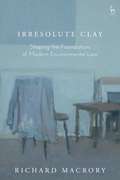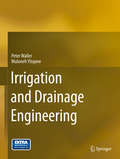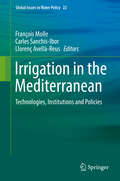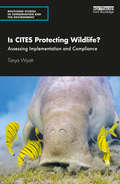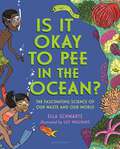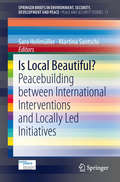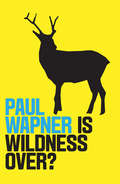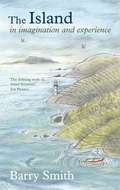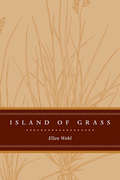- Table View
- List View
Ireland's Garden Birds: A Guide to Attracting and Identifying Garden Birds
by Oran O'Sullivan Jim WilsonAn essential companion for bird lovers and gardeners alike since it was first published, this highly successful guide to identifying garden birds has now been fully updated with the latest information and statistics. Highlighting a range of plants and planting schemes that support wildlife, it provides expert advice on making your garden a haven for birds. Learn everything you need to know about all the birds you’re most likely to see from your window, how to attract them into your garden and how to care for them. Each species is accessibly described, with details of identification, status and abundance, feeding habits, songs and call, and breeding season. The species guide has been updated to include the Great Spotted Woodpecker, which is now breeding regularly on the east coast and turning up in gardens. The species descriptions are enhanced by new photographs of the highest quality. Whether you are an avid gardener or just love feeding birds in your garden, this practical and easy-to-use guide is invaluable. Also available: 'Birds of Ireland – A Field Guide'
Ireland's Seashore: A Field Guide
by Lucy Taylor Emma NickelsenIreland’s seashores are famous for their spectacular beauty, ranging from exposed rocky headlands that receive the full power of the Atlantic to enclosed sea loughs and sheltered mudflats. Our northern latitude means that some Arctic species find a home here, but the warm currents that flow up from the Gulf of Mexico also make Irish shores habitable for species found in southern Europe, the Canaries and the Mediterranean. Providing habitats like no other, our coasts are teeming with plant and animal life. Whether you visit on a sunny summer day or for a wild walk in winter, there is always something interesting to see, either living on the shore or washed up from the sea. Beginning with clear background information on types of shore, tides, waves, coastal habitats and conservation, this highly accessible guide has everything you need to understand the wildlife on our coastline. A helpful identification guide uses simple questions (e.g. ‘Does it have a shell?’) to guide you to the correct section (e.g. ‘Snails, mussels and their relatives’), where you will find an introduction to the species, followed by detailed entries on the most common shoreline inhabitants: Irish and Latin names, size, distribution and memorable nuggets of information (did you know banded wedge shells can leap if disturbed?). Written by qualified marine biologists with a passion for their subject, this is the ideal companion on any seashore ramble, whether you are a beginner or an experienced naturalist.
Ireland's Trees – Myths, Legends & Folklore: Myths, Legends And Folklore
by Niall Mac CoitirName the five Great Trees of Ireland? What trees are most often found beside holy wells or cemeteries? Which tree gave the Red Branch Knights of Ulster their name? Ireland was once so heavily wooded it was said a squirrel could travel from Cork to Killarney without touching the ground. So it is no surprise that, in ancient Ireland, mythology and folklore were a part of the people's general knowledge about trees. Many of the myths and legends and much of the folklore associated with native trees persists to this day and are gathered together in this book.
Ireland's Wild Atlantic Way: A Walking Guide (A Walking Guide)
by Helen FairbairnThe Wild Atlantic Way follows the magnificent west coast of Ireland, passing golden beaches, thrusting headlands and soaring sea cliffs. Renowned walking-guide author Helen Fairbairn explores the best walking routes of the region, recommending trips to uninhabited islands, coastal mountains and much more. Routes vary from two to six hours, and are illustrated with colour photos and detailed maps. Whatever your level of expertise, this comprehensive guide is all you need to discover the real wonders of the Wild Atlantic Way. Praise for this author: ‘Handy, easy to use guide.’ Walking World Ireland. ‘Will be appreciated by local walkers and visitors alike.’ Irish Mountain Log. ‘Ideal for bringing out on a trail.’ The Irish Times Also by this author: ‘Dublin & Wicklow: A Walking Guide’, ‘Ireland’s Best Walks: A Walking Guide’, ‘Northern Ireland: A Walking Guide’
Ireland's Wild Plants – Myths, Legends & Folklore: Myths, Legends And Folklore
by Niall Mac CoitirIn ancient Ireland there were 365 different parts to the body, and a different plant to cure each part. So the wild plants of Ireland are bound up in our culture and folklore from the earliest times. To arry a four-leaved shamrock brings luck in gambling, while putting nine ivy leaves under her pillow means a girl will dream of her future husband. Here plants are described in seasonal order, a perspective dating back to our ancestors. Different aspects of plant folklore are examined following a brief history of traditional herbal medicine in Ireland. Included are their roles in magical protection, in charms and spells (especially for love!), as emblems in children’s games, and in Irish place names.
An Irish Atlantic Rainforest: A Personal Journey into the Magic of Rewilding
by Eoghan DaltunAn Post Irish Book Award Winner'An inspiring vision' Manchán Magan'The stories are absorbing, the writing charismatic and the ideas thought-provoking' Irish IndependentOn the Beara peninsula in West Cork, a temperate rainforest flourishes. It is the life work of Eoghan Daltun, who had a vision to rewild a 73-acre farm he bought, moving there from Dublin with his family in 2009. An Irish Atlantic Rainforest charts that remarkable journey. Part memoir, part environmental treatise, as a wild forest bursts into life before our eyes, we're invited to consider the burning issues of our time: climate breakdown, ecological collapse, and why our very survival as a species requires that we urgently and radically transform our relationship with nature. Powerfully descriptive, lovingly told, An Irish Atlantic Rainforest presents an enduring picture of the regenerative force of nature, and how one Irishman let it happen.
Irish birds (Collins Gem)
by David CabotAn introductory guide to 167 of the most frequently occurring birds in Ireland.
Irish Birds (Collins Gem Ser.)
by David CabotAn easy-to-use, fully illustrated guide to the birds of Ireland
An Irish Nature Year
by Jane PowersCall it a daily meditation on the world around us for nature-lovers and nature newbies alike, An Irish Nature Year gleefully explores the small mysteries of the seasons as they unfold – Who’s cutting perfect circles in your roses? Which birds wear feathery trousers? And what, exactly, is an amethyst deceiver?
Iron in Soils and Clay Minerals (Nato Science Series C: #217)
by J.W. Stucki B.A. Goodman U. SchwertmannProbably more than any other element, iron markedly influences the chemical and physical properties of soils and sediments in the earth. Considering its transition metal status, with potential variation in electronic configuration, ionic radius, and magnetic moment, combined with its abundance and relatively large mass, little wonder that one sees its unique influence on every hand. Pre sentations at the NATO Advanced Study Institute (NATO AS!) on Iron in Soils and Clay Minerals reviewed and discussed the occurrence, behavior, and properties of Fe-bearing minerals found in soils and in the clay mineral groups kaolinite, smectite, and mica. Also discussed at the NATO AS! were the basic chemical properties of Fe, methods for separating and identifying Fe in minerals, and the role of Fe minerals in weathering and other soil-forming processes. The present publication is the reviewed and edited proceedings of that Advanced Study Institute. The sequence of chapters follows the general pattern beginning with introductory chapters which overview the general occurrence of Fe in the earth and its chemistry, both generally and in mineral environments, followed by identification and characterization methods for Fe and Fe phases in minerals. The properties and behavior of Fe oxides, Fe-bearing clay minerals, and other Fe minerals in soils are then described, and the text ends with a summary of the role of Fe in soil-forming processes. A Table of Contents and subject index are provided to assist the reader in finding specific topics within the text.
Iron Nutrition in Plants and Rhizospheric Microorganisms
by Larry L. Barton Javier AbadiaThis book provides a comprehensive review on the status of iron nutrition in plants. It contains updated reviews of most relevant issues involving Fe in plants and combines research on molecular biology with physiological studies of plant-iron nutrition. It also covers molecular aspects of iron uptake and storage in Arabidopsis and transmembrane movement and translocation of iron in plants. This book should serve to stimulate continued exploration in the field.
Iron Nutrition in Soils and Plants: Proceedings of the Seventh International Symposium on Iron Nutrition and Interactions in Plants, June 27–July 2, 1993, Zaragoza, Spain (Developments in Plant and Soil Sciences #59)
by Javier AbadíaIron is a major constituent of the earth crust. However, under alkaline conditions commonly found in arid and semi-arid environments iron becomes unavailable to plants. When plants are affected by a shortage of iron their leaves become yellow (chlorotic), and both plant growth and crop yield are reduced. The roots of plants affected by iron deficiency may develop a series of responses directed to improve iron uptake, such as increased proton excretion and iron reduction capabilities or excretion of iron chela tors called siderophores. Iron deficiency affects major crops worldwide, including some of major economic importance such as fruit trees and others. Correction of iron deficiency is usually implemented through costly application of synthetic chelates. Since these correction methods are very expensive, the competitivity of farmers is often reduced and iron deficiency may become a limiting factor for the maintenance, introduction or expansion of some crops. In spite of the many years devoted to the study of iron deficiency, the knowledge of iron deficiency in soils and plants is still fragmentary in many aspects. We have only incomplete information on the processes at the molecular level that make some plant species and cultivars unable to take and utilize iron from the soil, whereas other plants grow satisfactorily under the same conditions.
Irreplaceable: The fight to save our wild places
by Julian HoffmanFor readers of George Monbiot, Mark Cocker and Robert Macfarlane - an urgent and lyrical account of endangered places around the globe and the people fighting to save them.All across the world, irreplaceable habitats are under threat. Unique ecosystems of plants and animals are being destroyed by human intervention. From the tiny to the vast, from marshland to meadow, and from Kent to Glasgow to India to America, they are disappearing.Irreplaceable is not only a love letter to the haunting beauty of these landscapes and the wild species that call them home, including nightingales, lynxes, hornbills, redwoods and elephant seals, it is also a timely reminder of the vital connections between humans and nature, and all that we stand to lose in terms of wonder and wellbeing. This is a book about the power of resistance in an age of loss; a testament to the transformative possibilities that emerge when people come together to defend our most special places and wildlife from extinction.Exploring treasured coral reefs and remote mountains, tropical jungle and ancient woodland, urban allotments and tallgrass prairie, Julian Hoffman traces the stories of threatened places around the globe through the voices of local communities and grassroots campaigners as well as professional ecologists and academics. And in the process, he asks what a deep emotional relationship with place offers us - culturally, socially and psychologically. In this rigorous, intimate and impassioned account, he presents a powerful call to arms in the face of unconscionable natural destruction.
Irresolute Clay: Shaping the Foundations of Modern Environmental Law
by Richard MacroryAt a time of profound change and rethinking, this book provides insights into how environmental law in the UK has developed into its current form, and considers challenges it will face in the future. Irresolute Clay is not a legal history or textbook, nor a conventional set of legal memoirs. Instead it offers a personal account of the inside stories as experienced by one of the key architects of contemporary environmental law. Taking a thematic approach, it charts fundamental tenets of the subject (such as environmental sanctions, the European dimension, developing the academic discipline of environmental law, and environmental courts and tribunals), from the beginnings of the modern environmental law era in the 1970s to the present day.
Irresolute Clay: Shaping the Foundations of Modern Environmental Law
by Richard MacroryAt a time of profound change and rethinking, this book provides insights into how environmental law in the UK has developed into its current form, and considers challenges it will face in the future. Irresolute Clay is not a legal history or textbook, nor a conventional set of legal memoirs. Instead it offers a personal account of the inside stories as experienced by one of the key architects of contemporary environmental law. Taking a thematic approach, it charts fundamental tenets of the subject (such as environmental sanctions, the European dimension, developing the academic discipline of environmental law, and environmental courts and tribunals), from the beginnings of the modern environmental law era in the 1970s to the present day.
Irrigation and Drainage Engineering
by Peter Waller Muluneh YitayewThis textbook focuses specifically on the combined topics of irrigation and drainage engineering. It emphasizes both basic concepts and practical applications of the latest technologies available. The design of irrigation, pumping, and drainage systems using Excel and Visual Basic for Applications programs are explained for both graduate and undergraduate students and practicing engineers. The book emphasizes environmental protection, economics, and engineering design processes. It includes detailed chapters on irrigation economics, soils, reference evapotranspiration, crop evapotranspiration, pipe flow, pumps, open-channel flow, groundwater, center pivots, turf and landscape, drip, orchards, wheel lines, hand lines, surfaces, greenhouse hydroponics, soil water movement, drainage systems design, drainage and wetlands contaminant fate and transport. It contains summaries, homework problems, and color photos. The book draws from the fields of fluid mechanics, soil physics, hydrology, soil chemistry, economics, and plant sciences to present a broad interdisciplinary view of the fundamental concepts in irrigation and drainage systems design.
Irrigation in the Mediterranean: Technologies, Institutions and Policies (Global Issues in Water Policy #22)
by François Molle Carles Sanchis-Ibor Llorenç Avellà-ReusMediterranean irrigation is diverse due to, among other factors, the relative importance of water in the economy of each country, varied levels of aridity, heterogeneous levels economic, social and technological levels of development, and differences in political and social organization. However, most of the Mediterranean countries face similar problems to meet their water demands because of the scarcity and variability of renewable resources, growing water requirements from non-agricultural sectors, increasing environmental concerns related to water quality and environmental degradation, a social demand for larger public participation, and important technological changes. The time has come to reconsider the “not one drop lost to the sea” philosophy of yesteryears largely and to 'live within limits'.This book focuses on eight selected countries (Tunisia, Morocco, Spain, France, Italy, Turkey, Israel and Egypt) and provides a comparative perspective that both thoroughly explores their specificities and identifies the common challenges faced by the irrigation sector in these countries. The book has been written at a critical moment, when the continued application of a supply-side water management model is revealing its unsustainable nature in numerous places; when significant technological changes are taking place in the irrigation sector; when new forms of management and governance are widely held as badly needed; and finally, when climate change is compounding many of the difficulties that have characterized irrigation policies and practices in the past decades.This complicated future context makes Mediterranean irrigation face various political dilemmas on water management, raising social tensions, triggering territorial and land conflicts, and stimulating new technological developments. This book provides a timely analysis of the particular trajectory of eight Mediterranean countries in these uncertain transformations, and attempts to identify the best strategies to avert or overcome future risks.
Is CITES Protecting Wildlife?: Assessing Implementation and Compliance (Routledge Studies in Conservation and the Environment)
by Tanya WyattThis book assesses the Convention on International Trade in Endangered Species of Wild Fauna and Flora (CITES), examining both implementation and compliance. Humans are causing a biodiversity crisis, where 1 million species are facing extinction. Species are dying, in no small part, because they are overexploited, poached and trafficked and CITES is the main international instrument designed to protect traded wildlife. Does the state of the world’s species mean CITES is failing? This book explores the implementation of and compliance with CITES by all 183 member countries. It is imperative we know the nature and extent of the implementation of and compliance with CITES legislation in all parties to fully understand the impact of legal and illegal trade on species survival. Through extensive legislative content analysis, a Delphi iterative survey, and semi-structured interviews, this is the first book to share empirical research about CITES implementation and compliance. This book contains a comprehensive analysis of the state of CITES, what is done well, what could be done better, and what the future might bring to try to curtail the slide of the world’s wildlife into extinction. By identifying lessons learned in relation to CITES legislation, implementation and compliance this book provides hard evidence to member countries as to how their own practice can be improved. This timely book will be essential reading for students and academics interested in wildlife law, trade and trafficking, green criminology and biodiversity conservation more broadly. It will also be of interest to professionals working in wildlife law enforcement.
Is CITES Protecting Wildlife?: Assessing Implementation and Compliance (Routledge Studies in Conservation and the Environment)
by Tanya WyattThis book assesses the Convention on International Trade in Endangered Species of Wild Fauna and Flora (CITES), examining both implementation and compliance. Humans are causing a biodiversity crisis, where 1 million species are facing extinction. Species are dying, in no small part, because they are overexploited, poached and trafficked and CITES is the main international instrument designed to protect traded wildlife. Does the state of the world’s species mean CITES is failing? This book explores the implementation of and compliance with CITES by all 183 member countries. It is imperative we know the nature and extent of the implementation of and compliance with CITES legislation in all parties to fully understand the impact of legal and illegal trade on species survival. Through extensive legislative content analysis, a Delphi iterative survey, and semi-structured interviews, this is the first book to share empirical research about CITES implementation and compliance. This book contains a comprehensive analysis of the state of CITES, what is done well, what could be done better, and what the future might bring to try to curtail the slide of the world’s wildlife into extinction. By identifying lessons learned in relation to CITES legislation, implementation and compliance this book provides hard evidence to member countries as to how their own practice can be improved. This timely book will be essential reading for students and academics interested in wildlife law, trade and trafficking, green criminology and biodiversity conservation more broadly. It will also be of interest to professionals working in wildlife law enforcement.
Is It Okay to Pee in the Ocean?: The Fascinating Science of Our Waste and Our World
by Ella SchwartzGet the facts you'll really want to know when you really need to go.Why do we pee? Is pee just yellow water? Is the ocean a giant toilet bowl (eww!)? If you've ever wondered about your body's waste . . . urine luck! This book is all about pee: from why and how we do it, to its effects on our world.Explore the human systems that make pee happen, tackle environmental questions about the impacts of human waste, discover surprising uses of urine throughout history-like in mouthwash and skin creams-and even try out at-home, hands-on experiments (with no bodily fluids required, of course!). With engaging black-and-white-illustrations and just enough ick-factor, this engrossing (and sometimes a little bit gross) book gets to the bottom of an oft-ignored part of the science of life.
Is Local Beautiful?: Peacebuilding between International Interventions and Locally Led Initiatives (SpringerBriefs in Environment, Security, Development and Peace #11)
by Sara Hellmüller Martina SantschiBased on the swisspeace annual conference 2012, the publication examines the delicate balance between external interventions and locally-led initiatives. It addresses the question of what “local” means in the peacebuilding and development context; which actors on the ground actually represent the local level and how external actors choose their partners from amongst them. Moreover, it examines how local ownership - emerging as key criteria for any external intervention - is constituted: does this concept only imply local participation or is local control from the outset a must? Finally, it assesses the potential of locally-led initiatives and local conflict resolution mechanisms and their interaction with external interventions. Several authors provide insights on these questions and nuance our thinking about both local ownership and external interventions. As such, the publication aims to encourage critical reflections on this topical debate in peacebuilding and development.
Is Wildness Over? (Where Am I?)
by Paul WapnerWildness was once integral to our ancestor’s lives as they struggled to survive in an unpredictable environment. Today, most of us live in relative stability insulated from the vicissitudes of nature. Wildness is over, right? Wrong, argues leading environmental scholar Paul Wapner. Wildness may have disappeared from our immediate lives, but it’s been catapulted up to the global level. The planet itself has gone into spasm - calving glaciers, wildfires, heatwaves, mass extinction, and rising oceans all represent the new face of wildness. Rejecting paths offered by geoengineering and de-extinction to bring the Earth under control, Wapner calls instead for ‘rewilding’. This involves relinquishing the desire for comfort at all costs and welcoming greater uncertainty into our own lives. To save ourselves from global ruin, it is time to stop sanitizing and exerting mastery over the world and begin living humbly in it.
La isla del tesoro
by Robert Louis StevensonLa isla del tesoro (1883), una vibrante historia sobre la búsqueda de un tesoro enterrado, presenta el bien bajo la forma de Jim, un niño que se ve envuelto en la aventura y que a su vez debe descubrir por sí mismo la cara del bien y del mal entre sus bondadosos amigos y los piratas Pew y Long John Silver.
The Island in Imagination and Experience: Antarctica And Subantarctic Islands 1959-2006
by Barry SmithFrom Treasure Island to Robben Island, from the paradise of Thomas More's 'Utopia' to Napoleon's purgatory on Elba, islands have proved irresistible to mankind's imagination since time immemorial. Self-confessed islomaniac Barry Smith explores how islands bewitch us so, and examines the kind of human experiences that islands inspire. Journeying all around the globe to take in the most fascinating stories of Earth's half a million islands, this book considers the unique geography, politics and economics of islands and their cultures. It traces their singular place in literature, religion and philosophy, and disentangles the myths and the facts to reveal just why islands exert such an insistent grip on the human psyche. 'Fascinating and wide-ranging.' Island Review 'A fascinating survey of the interplay between those little dots of land and the human imagination… Smith is excellent on the ways in which islands have always been pawns in geopolitical games…witty.' Geographical "Magisterial… A harrowing, enthralling piece of work that bears comparison with John Prebble's equally dense, equally passionate classic, The Highland Clearances … [A] fascinating, scrupulous, angry, scholarly book." Jim Perrin, The Great Outdoors
Island of Grass
by Ellen E. WohlIsland of Grass tells the story of the Cathy Fromme Prairie Natural Area, a 240-acre preserve surrounded by housing developments in Fort Collins, Colorado. This small grassland is a remnant of the once-vast prairies of the West that early European explorers and settlers described as seas of grass.Agricultural land use and urban expansion during the past two centuries have fragmented and altered these prairies. All that remains today are small islands. These remnants cannot support some of the larger animals that once roamed the prairie, but they continue to support a diverse array of plants and animals and can still teach us much about grassland ecology. Through her examinations of daily changes during walks across the Fromme Prairie over the course of a year, Ellen Wohl explores one of the more neglected ecosystems in North America, describing the geology, soils, climate, ecology, and natural history of the area, as well as providing glimpses into the lives of the plants, animals, and microbes inhabiting this landscape. Although small in size, pieces of preserved shortgrass prairie like the Cathy Fromme Prairie Natural Area are rich, diverse, and accessible natural environments deserving of awareness, appreciation, and protection. Anyone concerned with the ecology and conservation of grasslands in general, the ecology and conservation of open space in urban areas, or the natural history of Colorado will be interested in this book.
